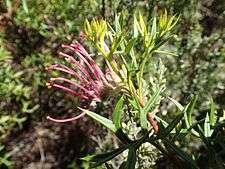Grevillea acanthifolia
| Grevillea acanthifolia | |
|---|---|
 | |
| Grevillea acanthifolia flowers near Blackheath | |
| Scientific classification | |
| Kingdom: | Plantae |
| (unranked): | Angiosperms |
| (unranked): | Eudicots |
| Order: | Proteales |
| Family: | Proteaceae |
| Genus: | Grevillea |
| Species: | G. acanthifolia |
| Binomial name | |
| Grevillea acanthifolia A.Cunn. | |
Grevillea acanthifolia, commonly known as the Acanthus-leaved grevillea, is a plant in the Proteaceae family and is endemic to New South Wales. It is a shrub with stiff, prickly, divided leaves and pink to purple "toothbrush" flowers.
Description
Grevillea acanthifolia is an erect or spreading shrub which usually grows to a height of 0.5 m (2 ft) but sometimes to 3 m (10 ft) tall and 4 m (10 ft) wide. The leaves are have 9 to 14 main lobes and are 4–9 cm (2–4 in) long and 3–7 cm (1–3 in) wide, each lobe sometimes further divided and linear to triangular or wedge-shaped with a sharp tip. The leaves are bright green, stiff and prickly.[1][2][3][4]
The flowers are arranged in one-sided, "toothbrush"-like group, 3–10 cm (1–4 in) long. The small sepals and petals are pale green to grey and hairy on the outside and glabrous inside. The style is 20–28 mm (0.8–1 in) long and red, tipped with a green pollen presenter. Flowering occurs throughout the year but mainly from October to February and the fruit that follows is a hairy follicle with reddish markings.[1][2][3][4]

.jpg)
Taxonomy and naming
Grevillea acanthifolia was first formally described in 1825 by Allan Cunningham from a specimen he collected on John Oxley's 1817 expedition. Cunningham found the species growing in "peaty bogs on the Blue Mountains and [on the] banks of Cox's River".[5] The specific epithet (acanthifolia) is a derived from the name of the genus Acanthus and the Latin word folium meaning "a leaf"[6] referring to the similarity of the leaves of this species to those of Acanthus.[2]
Three subspecies have been identified as follows:
- Grevillea acanthifolia A.Cunn. subsp. acanthifolia which has its leaf lobes egg-shaped or wedge-shaped, not linear and which grows in swampy places or on wet rocks in the Blue Mountains;[7][8]
- Grevillea acanthifolia subsp. paludosa Makinson & Albr. commonly known as bog grevillea which is an erect shrub growing to a height of 3 m (10 ft) with narrow, tapering or linear leaf lobes which are more or less hairy on the lower surface and which grows in swamps an on stream sides at high altitudes, inland from Bega;[9][10]
- Grevillea acanthifolia subsp. stenomera (F.Muell. ex Benth.) McGill. which usually only grows to a height of less than 1 m (3 ft), has narrow, tapering or linear and glabrous leaf lobes and which grows on the Northern Tablelands and higher parts of the North Coast.[11][12]
Grevillea × gaudichaudii is a hybrid derived from G. acanthifolia and Grevillea laurifolia.
Distribution and habitat
This grevillea only grows in New South Wales, usually at higher altitudes and in wet or boggy areas.[1]
Conservation
Subspecies stenomera is classified in the ROTAP system as 3RC-[12] meaning that it has a wide range but small populations and is rare, but at least some populations are in reserves and the species not at present under threat.[13] Subspecies paludosa is classified as "Endangered" under the NSW Threatened Species Conservation Act and under the Commonwealth Government Environment Protection and Biodiversity Conservation Act 1999 (EPBC) Act. The main threats to its survival are habitat loss, changes to river flow regimes and trampling and grazing by stray domestic animals.[14][15]
Use in horticulture
Subspecies acanthifolia of this grevillea is grown in some gardens but is sometimes unreliable at low altitudes. It grows best in a sunny position and is tolerant of heavy frosts.[2]
References
- 1 2 3 Makinson, Robert Owen. "Grevillea acanthifolia". Royal Botanic Garden Sydney:plantnet. Retrieved 13 November 2016.
- 1 2 3 4 "Grevillea acanthifolia". Australian Native Plants Society Australia. Retrieved 13 November 2016.
- 1 2 Sheather, Warren; Sheather, Gloria. "Grevillea acanthifolia". A View from Yallaroo. Retrieved 13 November 2016.
- 1 2 Carolin, Roger; Tindale, Mary (1994). Flora of the Sydney region (4th ed.). Chatswood, NSW: Reed. p. 268. ISBN 0730104001.
- ↑ "Grevillea acanthifolia". APNI. Retrieved 13 November 2016.
- ↑ Brown, Roland Wilbur (1956). The Composition of Scientific Words. Washington, D.C.: Smithsonian Institution Press. p. 340.
- ↑ "Grevillea acanthifolia subsp. acanthifolia". APNI. Retrieved 13 November 2016.
- ↑ Makinson, Robert Owen. "Grevillea acanthifolia subsp. acanthifolia". Royal Botanic Garden Sydney:plantnet. Retrieved 13 November 2016.
- ↑ "Grevillea acanthifolia subsp. paludosa". APNI. Retrieved 13 November 2016.
- ↑ Makinson, Robert Owen. "Grevillea acanthifolia subsp. paludosa". Royal Botanic Garden Sydney:plantnet. Retrieved 13 November 2016.
- ↑ "Grevillea acanthifolia subsp. stenomera". APNI. Retrieved 13 November 2016.
- 1 2 Makinson, Robert Owen. "Grevillea acanthifolia subsp. stenomera". Royal Botanic Garden Sydney:plantnet. Retrieved 13 November 2016.
- ↑ "Threatened flora lists". Australian Native Plants Society Australia. Retrieved 13 November 2016.
- ↑ "Bog grevillea profile". New South Wales Government Office of Environment and Heritage. Retrieved 13 November 2016.
- ↑ "Approved conservation advice for Grevillea acanthifolia subsp. paludosa (Bog grevillea)" (PDF). Australian Government Department of the Environment. Retrieved 13 November 2016.